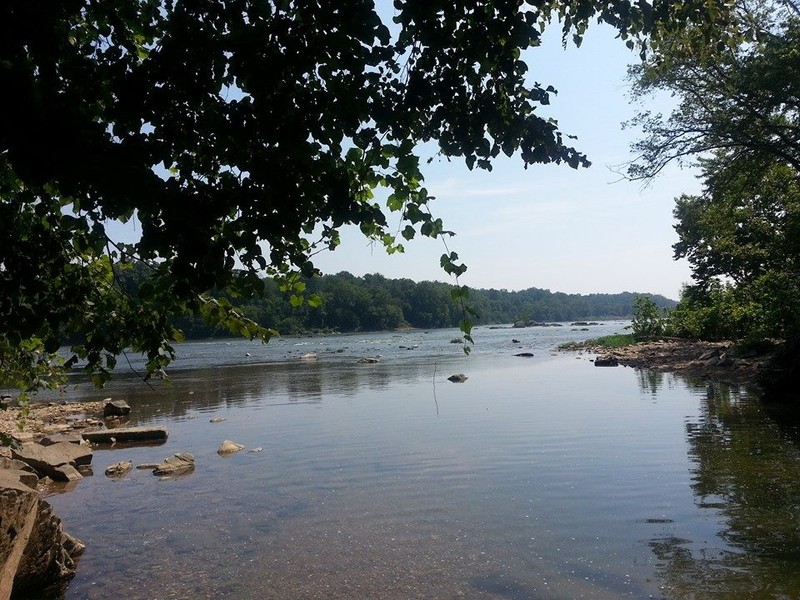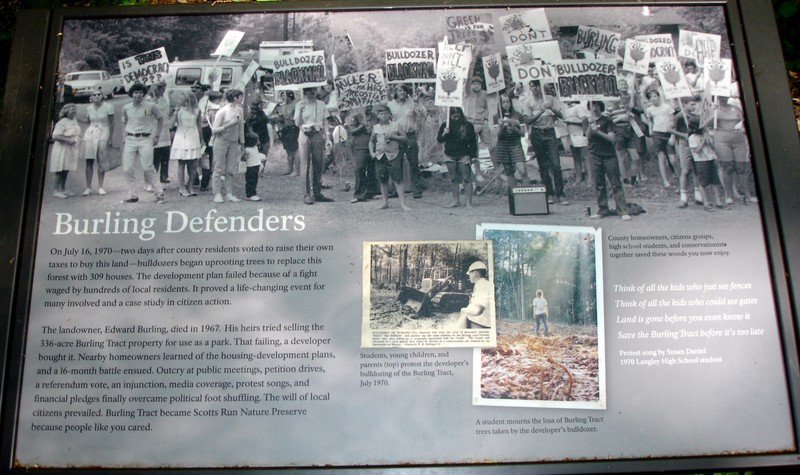Scott's Run Nature Reserve
Introduction
Text-to-speech Audio
Images
Scott's Run and the Potomac River on the northwest corner of Scott's Run Nature Preserve by NortyNort on Wikimedia Commons (CC BY-SA 4.0)

Burling Defenders Marker on hmdb.org

Backstory and Context
Text-to-speech Audio
The Scott's Run creek area has long been known for its lush spring wildflowers, mature forest, and geological uniqueness. The park is part of the Potomac Gorge, where erosion and an ancient fault zone have shaped a landscape rife with rare or unusual plant and animal species. The unpredictable and changeable creek runs into the Potomac River.
Edward B. Burling, Sr., a successful Washington, D. C., lawyer, bought the 336-acre tract of land in the 1920s and kept a cabin on the property as a personal and social retreat for Washington elite. Burling refused to sacrifice any trees for the installation of telephone lines.
After Burling's death in 1966, his heirs tried selling the land for a park, then to a developer Miller & Smith Associates. Miller & Smith purchased the land for $2.4 million, planning to build 309 luxury homes on the site, each estimated at a value of $68,0000 to $100,000. Their plan, generally supported by the county government, was to preserve 52% of the land as open space.
Elizabeth Miles Cook, an artist and Quaker, saw the county's notice of a public hearing before the Planning Commission and rallied residents against the development of the land. Public outcry ensued for over a year; residents confronted the plan peacefully through public meetings, petitions, and protests. Students went door-to-door to raise awareness and wrote protest songs. Although many organizations of government and citizens' groups stood on the side of development in the beginning, those opposed to the development continued to act. The New York Times covered the story, and several prominent figures -- a businessman and four U. S. Senators -- supported the environmental advocates.
The citizens' engagement led to a referendum vote. The Dranesville district voted to raise its own taxes on July 14, 1970, in order to buy the land for $1.5 million, 3208 to 2758. Development almost began anyway, with bulldozers beginning to uproot trees two days later. About 75 protestors met them with signs and noise. Virginia Governor Lynwood Holton appealed to developers to halt the razing of the forest until the county produced the funding to buy the land. Scott's Run finally became public land in September 1970. A marker at the park commemorates the activism of the "Burling Defenders."
The Farifax County Park Authority now maintains Scott's Run, with the help of volunteers and the Potomac Heritage Trail Association. Hiking trails, including the Potomac Heritage National Scenic Trail, run through the park. The Park Authority holds educational and nature programs for the public at the site.
Sources
--. Burling Defenders, Historical Marker Database. October 20th 2018. Accessed December 5th 2019. https://www.hmdb.org/marker.asp?marker=125175.
Fairfax County Park Authority. Scott's Run Nature Preserve, 2019. Accessed December 7th 2019. https://www.fairfaxcounty.gov/parks/scottsrun/.
Kunkle, Fredrick. "Fairfax Set to Commemorate the Battle for Scotts Run." Washington Post (Washington, DC) July 11th 2009. Accessed December 5, 2019. https://www.washingtonpost.com/wp-dyn/content/article/2009/06/09/AR2009060903699.html.
https://commons.wikimedia.org/wiki/Category:Scott%27s_Run_Nature_Preserve#/media/File:Scott's_Run_Potomac.jpg
https://www.hmdb.org/PhotoFullSize.asp?PhotoID=107936
